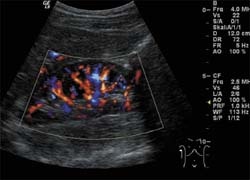Under- or over-utilised?
By Dr Soenke H Bartling
Although ultrasound imaging is a very powerful imaging modality it is mostly under-used
Ultrasound combines several very appealing characteristics. It is among the non-invasive imaging modalities, indeed it is really non-invasive. Similar to MRI, no harm to the patient can be caused by ultrasound.

Through the years it has witnessed great developments: Resolution increased, functional modes have been added and novel contrast concepts invented. It constantly served doctors during the last decades. Often, it can be used to replace more expensive and more invasive (‘harming’) modalities. The latest developments have made ultrasound devices small and flexible so that they can even be carried in ambulatory or preclinical medicine. Novel ultrasound probes were reduced in size and made 3-D, or better, 4-D imaging possible – most famously ‘baby-facing’, where a mother-to-be can see the face of her unborn child in 3-D.
However, many still maintain that the power of ultrasound is under-utilised, whilst others say it is over-utilised.
To explain this apparent discrepancy one has to understand that ultrasound is an imaging modality that is strongly dependent on the training level of the operator. The probes give insight into parts of the human body, but only those that are looked at. Furthermore, in contrast to all other imaging modalities, ultrasound does not allow a profound documentation of the findings – at least not those findings that weren’t seen during the examination. An ultrasound examination cannot be looked at retrospectively. In other words, there are almost no consequences for a doctor if he misses some findings. This has led to ultrasound mostly being used for screening and not the final ‘elimination’.
To compensate for declining reimbursements for ultrasound, doctors increased (over-utilised) the number of examinations, which itself leads to a consecutive decrease in reimbursement, despite the fact that a good ultrasound examination takes time. So, to perform a really good ultrasound examination no longer pays well.
While in many countries a wide variety of doctors perform ultrasound – radiologists as well as specialists and general practitioners – in the USA the problem of a declining reimbursement has been solved differently: radiographers perform very standardised scan protocols that are then read by radiologists.
Independent of widely discussed local implementations, the potential of ultrasound is not used to its full extent – healthcare politicians (adopting reimbursement, assure quality examiners) as well as the healthcare industry (make ultrasound less user dependent, develop new probes, assure proper documentation) have the potential to change this in the future.
01.09.2008










